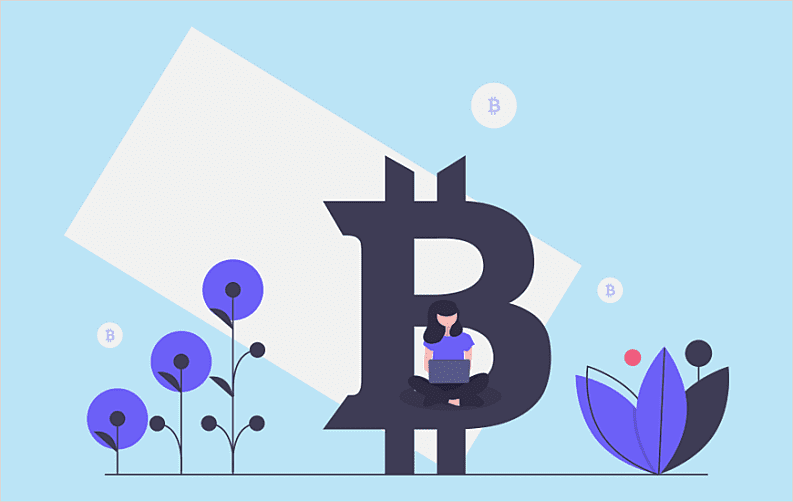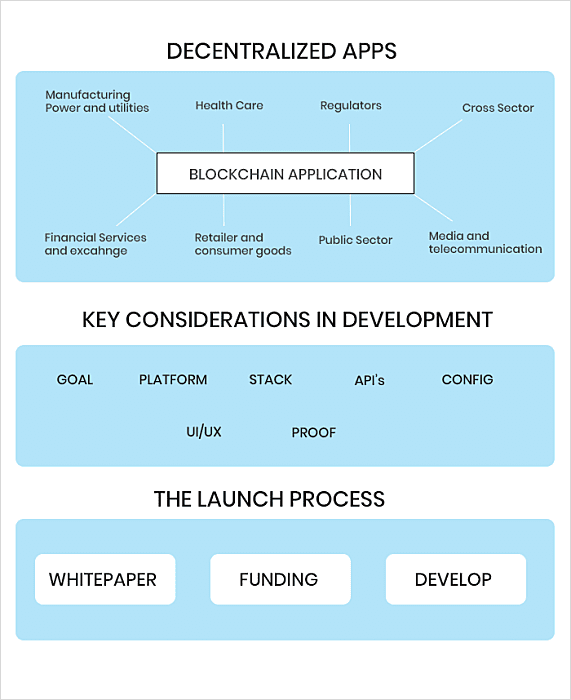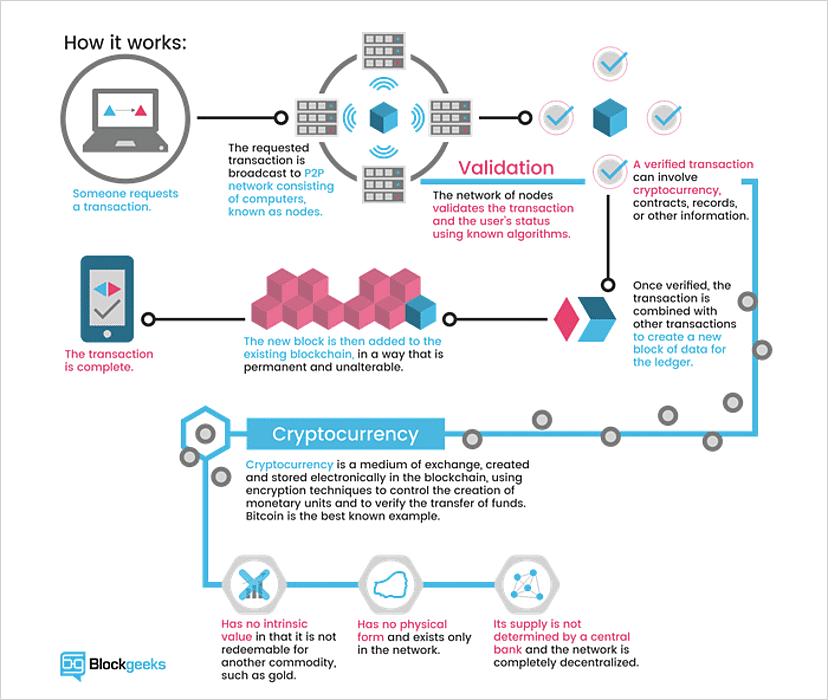
Blockchain has remarkably transformed the way businesses conduct transactions. Apart from bring secure, this open, disruptive technology is also lowering costs, speeding up processes, and building a new level of trust. When something as giant as the blockchain emerges from its shackles, developers are expected to take the driver’s seat and learn how to develop blockchain applications. It is the new in-thing today for app developers. Why?
As per a recent study on the requirements of blockchain engineers, there are 14 jobs available for a single professional. Yes, you read that right. This speaks volumes of the scarcity we have today in the blockchain technology.
How to Create a Blockchain
To develop a simple blockchain app, we’ve beginner level steps to make the whole process a tad bit easier. But before we dive into it, let’s see the use of blockchain apps in various sectors, the updations in blockchain app development, and the process that blockchain app developers follow.

It is beyond the benefit of a doubt that we are in the era of blockchain technology but the golden period is yet to come. We all remember the hype that felt like a tsunami when blockchain was first introduced eleven years ago.
The recent boom in the industry is another example of how much the blockchain technology is adored by tech enthusiasts, app developers, and even the average user. The blockchain is here to stay for a long time. And our goal is to educate even the non-tech users to get the hang of this world-shaking technology. Let the coding begin, but only after a preview of how the blockchain technology works.

Milestone 1: Glossary Basics
The blockchain is still enjoying the status of being an innovative and revolutionizing technology that is not known to many. So let’s start by taking a look at the basic terms that will be used further in this article.
1. What Is A Blockchain App?
The blockchain is a chain of blocks wherein each block has a certain value. The transaction on the blockchain is made through bitcoins and other cryptocurrencies.
2. What Is Decentralization?
The blockchain technology is said to be decentralized as there is no central authority that covers these things. All the blockchain blocks are connected to one another in the system and get the information that a transaction is being done. However, no one gets the information about the person making the transaction.
3. Who Are Miners?
In case of the blockchain technology, the blocks are mined and the users mining them are called miners.
The sphere of the blockchain technology is much wider than human imagination and therefore it is advisable to go through the blockchain glossary here. And to have an in-depth understanding of what blockchain technology actually is all about, go through our guide here.
If this doesn’t satiate your nerdiness, check out Satoshi Nakamoto’s whitepaper on bitcoin.
Milestone 2: How to Code a Blockchain
Just like any other mobile application, Blockchain apps also have a structure that includes coding for the front-end and back-end, too. However, you will come across tons of challenges.
But before presenting you with the coding blocks, here are some of the main keywords you should remember:
- This: The keyword has been invoked inside a function to access its value inside a specific object in order to call that particular function.
- Constructor: The object creates an object inside a class. Each class is limited to only one constructor.
Now the basics are clear, allowing me to move further to the coding charts.
const SHA256 = require("crypto-js/sha256")
class Block
constructor(index, timestamp, data, previousHash = '')
this.index = index;
this.previousHash = previousHash;
this.timestamp = timestamp;
this.data = data;
this.hash = this.calculateHash();
calculateHash()
return SHA256(this.index + this.previousHash + this.timestamp + JSON.stringify(this.data)).toString();
}
1. Code Investigation: The Analysis
- The first line of code is to call the crypto-js library as the sha256 hash function is not available in JavaScript.
- Next, a constructor is invoked inside the class to call for objects that have certain values.
- The code has been designed to get the hash of a particular block. The JSON.stringify function has been used to turn the data of the block into a string to hash it.
- With this setting, we now have the blockchain blocks ready. After that, these blocks are connected together to the main blockchain.
2. How to Build a Blockchain
class Blockchain
{
//Section 1 Genesis block creation
constructor()
this.chain = [this.createGenesisBlock()];
createGenesisBlock()
{
return new Block(0, "01/01/2017", "Genesis block", "0");
//section 2 adding new blocks
getLatestBlock()
return this.chain[this.chain.length - 1];
addBlock(newBlock) {
newBlock.previousHash = this.getLatestBlock().hash;
newBlock.hash = newBlock.calculateHash();
this.chain.push(newBlock);
//section 3 validating the chain
isChainValid()
for (let i = 1; i < this.chain.length; i++)
const currentBlock = this.chain[i];
const previousBlock = this.chain[i - 1];
if (currentBlock.hash !== currentBlock.calculateHash()) {
return false;
if (currentBlock.previousHash !== previousBlock.hash)
return false;
return true;
}
3. Code Investigation: The Analysis
We will be breaking the code here to offer you a better insight.
The very first section of the coding represents the creation of the genesis block with the following codes:
createGenesisBlock()
{
return new Block(0, "01/01/2017", "Genesis block", "0");
}
The genesis is the very first block. The thing that makes it special is that it does not point to the previous block as every block in the blockchain structure does. Let’s Proceed To Another Section:
4. Adding The Blocks
To add the blocks, we need to know which is the last block in the current blockchain technology. For the same, we used the following functionality.
getLatestBlock()
return this.chain[this.chain.length - 1];
Now that we have determined the latest block, let’s see how we are going to add new blocks.
addBlock(newBlock) {
newBlock.previousHash = this.getLatestBlock().hash;
newBlock.hash = newBlock.calculateHash();
this.chain.push(newBlock);
}
By far we know the hash value of the last block is the same as the value of the currently created block. So, how can we find out these values? Simply by measuring their values.
If both the values are equal it means the blocks are justified.
5. Chain Validation
Now it comes to checking the validation and the stability of the codes and for the same, the coding goes as displayed below in the table. The “for” loop is to go from block 1 to the last block.
for (let i = 1; i < this.chain.length; i++)
const currentBlock = this.chain[i];
const previousBlock = this.chain[i - 1];
In this part of the code we are defining two terms, current block and previous block. And now we are simply going to find the hash of these two values.
if (currentBlock.hash !== currentBlock.calculateHash()) {
return false;
if (currentBlock.previousHash !== previousBlock.hash)
return false;
return true;
}
As explained above, the previous block value must equal the value of the newly created one and in this case, if the value is met, the function will return true. In case, the value is not met, it will return to being false.
6. The Final Coding
let BlockGeeksCoin = new Blockchain();
BlockGeeksCoin.addBlock(new Block(1, "20/07/2017", { amount: 4 }));
BlockGeeksCoin.addBlock(new Block(2, "20/07/2017", { amount: 8 }));
And now you are done with the basic blockchain application. We just successfully coded a new blockchain-based cryptocurrency and that is named as BlockGeeksCoin. Here, the Genesis block was developed automatically once the constructor was activated.
Milestone 3: Basics Of Smart Contracts
Smart contracts facilitate the exchange of money, property, and other valuable objects without the involvement of a middleman. Smart contracts need to run on multiple nodes without compromising on integrity. The infographic below gives an insight into how the technology works.
Major Benefits Of Blockchain Applications
Blockchain based applications offer ample of benefits from transparency and decentralization, to easy accessibility. Let’s take a look at all of them in detail.
1. Transparency
Blockchain apps offer ultimate transparency as there is no involvement of middlemen in any of the transactions. However, the level of transparency may differ from one observer to another. When a transaction is made by one party to another, the transaction remains transparent to everyone, i.e. anyone and everyone in the chain can view the activity.
2. Decentralization
One of the most important benefits of blockchain is that there is no requirement of a third party resource or any intermediary to validate the transaction. The consensus mechanism is all that is required to agree on the transaction mutually.
3. High Availability
The peer-to-peer blockchain application is based on thousands of nodes and the data is updated on every node. This way, the system becomes highly-available. Even if the nodes become inaccessible, the advanced system, as a whole, will continue to work, thus making the complete blockchain network highly accessible.
4. Highly Secured
Cryptographically, all transactions on a blockchain are secured as each transaction is tied to a previous transaction.
5. Faster Dealing
Blockchain plays a crucial role when it comes to functions like trade-settlement that contribute to leveraging a much faster deal. On a side note, the process of verification is not lengthy as compared to other such processes. There is no involvement of any middleman here, which also means that the transaction can be done much faster.
6. Cost Effective
No third party involvement is required in blockchain transactions and thus, it eliminates the additional costs associated with a middleman in such transactions.
What’s Next?
Another important thing that every aspiring developer should keep in mind is to stay ahead with every major development in the blockchain sector. We recommend you to join various online forums where healthy discussions are frequently held.
However, such beginner knowledge of blockchain wouldn’t do the job for you and so it is recommended that you hire a leading blockchain app development company that can build a blockchain application as per your requirements.
Being a part of the Reddit community will certainly help in gaining more proficiency, while Github pages and stock exchange are other sources of information for a budding developer.
This beginner’s guide will not only give a kickstart in the world of blockchain development but will also help you polish your basic skills of coding. However, this won’t be enough to let you become a comprehensive blockchain coder. Keep reading more and practicing as much as you can to gain expertise.
















